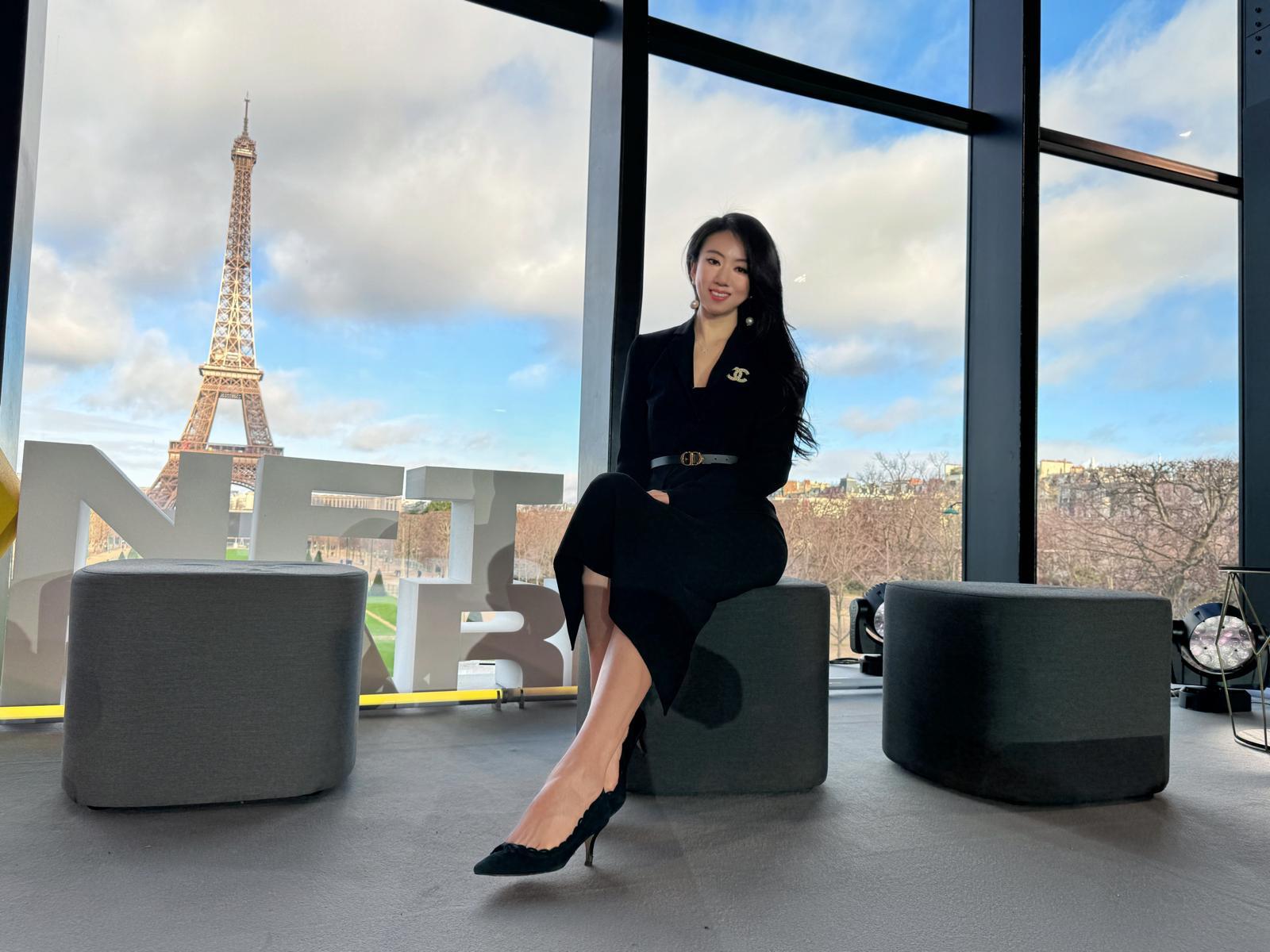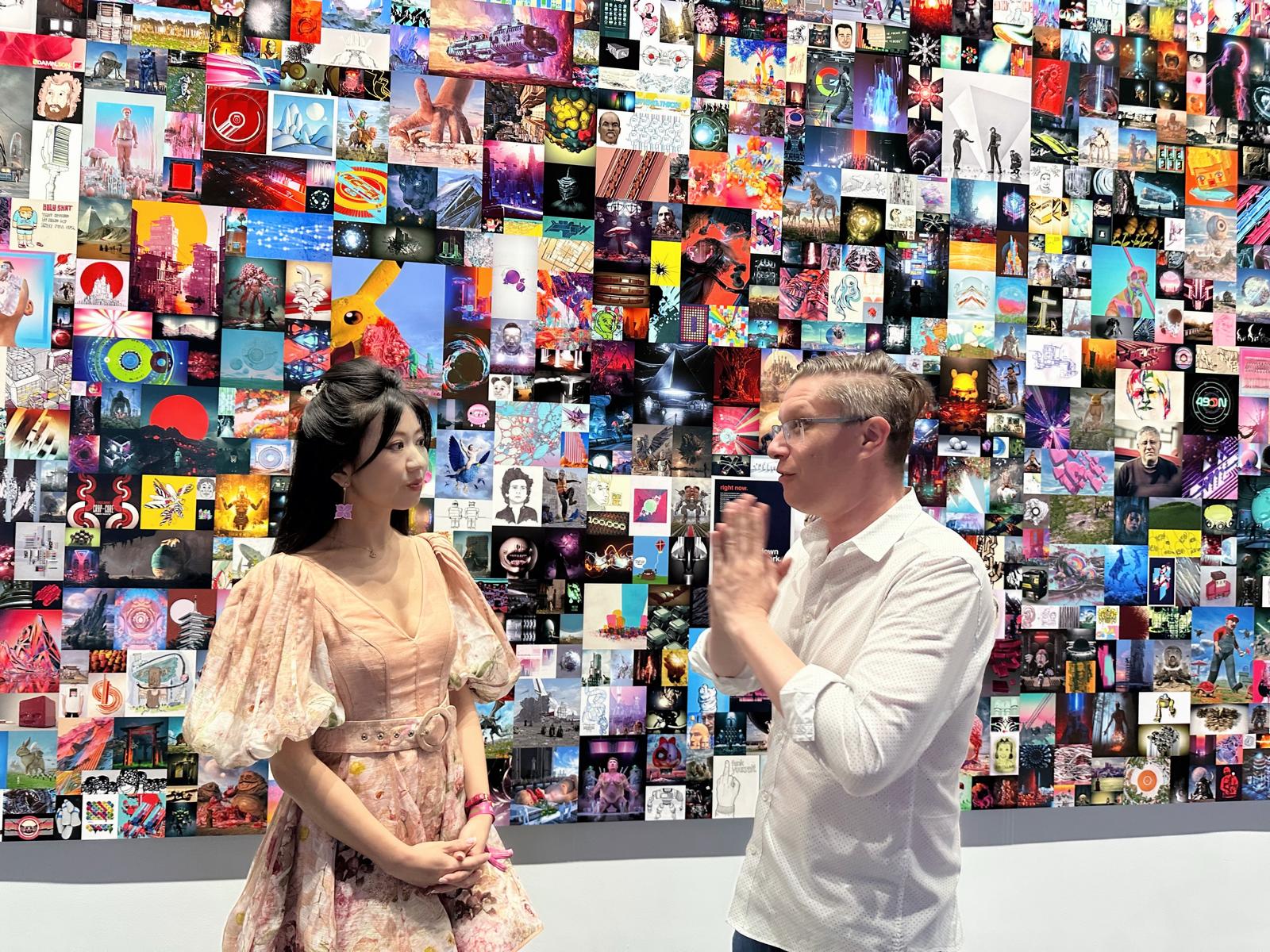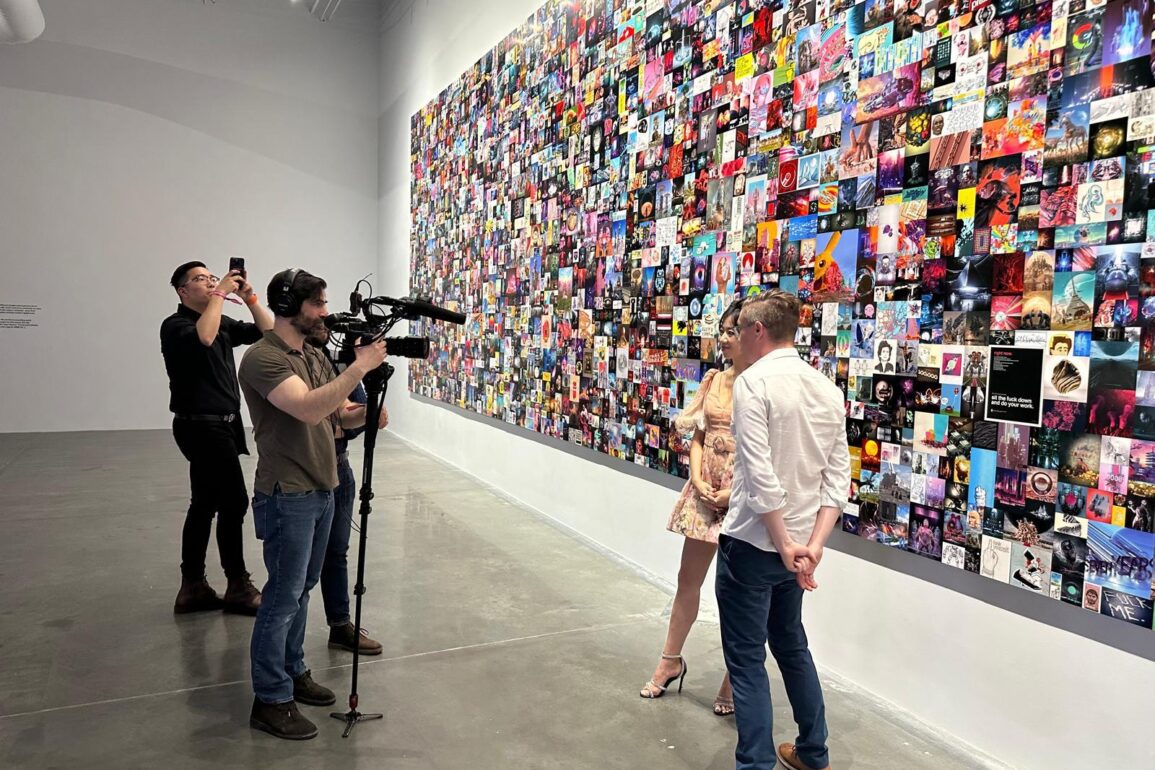 Artist BEEPLE filmed in front of his famous NFT work “Everyday: 5000 Days”
Artist BEEPLE filmed in front of his famous NFT work “Everyday: 5000 Days”
By COCO DOLLE July 8, 2024
Produced by Springna Zhao and Barry Alexander Brown.
With the emergence of the metaverse and the rapid advancement of AI, unraveling the complexities of the digital realm remains an expansive and largely unexplored aspect of our cultural landscape. Despite last year’s crypto market crash, interest in the phenomenon, particularly post-NFTs, continues to captivate a niche audience of visionaries and experts dedicated to educating the broader public about art, technology, and the digital domain.
The documentary “NFTY30” has not yet been released to the public, but it is poised to inspire curiosity and spark conversations that demystify the intricate world of Web3, bringing together high profile artists and powerful voices in the web3 space, including nft.now founder Matt Medved and Bitforms gallery owner Steven Sacks.
I met with its principal producer, Springna Zhao, after she showcased the film at the recent Cannes Film Festival to discuss its development and behind-the-scenes insights.
 Producer Springna Zhao at NFT Paris, 2024
Producer Springna Zhao at NFT Paris, 2024
Coco Dolle: What was the inspiration behind NFTY30 and what motivated you to create a documentary exploring the intersection of art, the metaverse, and artificial intelligence?
Springna Zhao: I dove into the space in 2021 with the peak of NFTs and was fascinated by the shows of digital arts in Art Basel based on blockchains. I wanted to fully understand the space and its promises to us as a human race. I also realized 99% of the world population then did not know what NFTs really are, so I wanted to create a film that is entertaining, educational, exciting, intriguing, and provocative yet thought-provoking for anyone who wants to be informed about this space. It has grown so much from this idea and evolved with the fast-changing tech realm including metaverse and artificial intelligence.
CD: NFTY30 boasts an mpressive lineup of notable figures in the emerging tech field, including Beeple, Haider Rafique, and representatives from the Bored Ape Yacht Club. How did you go about selecting these individuals to feature in your documentary?
Springna Zhao: I studied this new cultural landscape looking at identifying key figures who have made significant contributions or have unique perspectives within the subject matter. For instance, Beeple’s impact on digital art, with his $69m sales of Everyday: 5000 Days. Haider Rafique’s expertise in blockchain, NFTs, and AI with OKX, the world’s second-largest blockchain company. Their involvement adds depth and credibility to the narrative while providing insights into different aspects of the field. I further identified icons who demonstrate ethics and integrity while enjoying tremendous accomplishment and success. There are lots of rug pulls and bad actors in space, and I truly want to focus on the leaders who build good and meaningful projects and who not only have themselves in mind but also the future of mankind. Refik is a great example and is one of the most notable machine-learning multimedia artists. He donated $2.5 million worth of proceeds from his art generated from the wind data of the Amazonian people. Brittany Pierre is a self-taught and self-made multi-disciplinary NFT artist who raised funds to support chariots in Chicago. And last, identifying the luminaries with the same vision to share their personal stories and transformation through this emerging tech and to address the beauties and risks caused by the adoption of the tech, who are passionate about educating people about the space.
CD: Collaboration is a key aspect of NFTY30, with partnerships with industry icons Spike Lee and Barry Alexander Brown. Can you share how these partnerships came about and how they influenced the direction of the documentary?
Springna Zhao: Barry Alexander Brown was nominated by the Oscars for Best Film Editing and also won the Lifetime Achievement Award at the Cannes Film Festival. He has been a partner with Spike Lee for over 40 years and edited and partnered on Spike’s most famous films from Do the Right Thing to BlacKKKlansman. Besides that and most importantly to me, he is a dear friend and mentor for my journey as a producer, and my Executive producer of this film. He was with me from the beginning of his idea till I founded a team to make this dream come true. Partnership with him is extremely instrumental. He is with me from brainstorming to production to editing. He was on every all I had with the production team and watched 82 edits of the film. He is one of the best filmmakers in the world who possesses not only great talent and a keen passion for excellent filmmaking but also a generous heart and giving spirit to upcoming young filmmakers like myself. I consider myself extremely fortunate to have Barry on my side, and on my team.
When I told Barry I wanted to make a documentary about NFTs (where I got started even though the film has grown to be so much more than that), he asked me “What’s that?” But he was open-minded, quick to absorb and learn all of the new information about this fascinating world. His prediction also influenced how I looked at the storytelling of the film from an outsider’s view since I am so close to the space and people I reviewed. Barry gave me a fresh look at the angles most of the audiences may appreciate when they watched the film as newcomers to the space. But now Barry is a total pro of web3 and he might have avatars for his next film!
So this collaboration is just so profound in every way possible. His sense, sensibility, and brilliant notes in every editing section also helped me shape the film into the final product we are proud of. I remember his comment from the last meeting where he said, “This film is right, excellent, and we are done! “ I cannot help but smile so big with tears in my eyes. One of the best moments in my life.
CD: As the first Hollywood Web3 documentary, what unique challenges did you encounter during the production process, and how did you overcome them?
Springna Zhao: One of the biggest challenges I had to face for this particular documentary is the Fast-Paced Industry: The rapid evolution of the web3 space means that information and trends can become outdated quickly. Keeping the documentary current and relevant amidst this fast-paced environment would require constant updates and flexibility in production. I started with the thought to make a film about NFTs and now it has grown to cover the thesis beyond that including blockchain, metaverse, and AI.
The second biggest challenge is to form my team. I built my team from scratch, from production, post-production, administration, and sales. I have learned to only work with professionals with the right attitude, ethics, integrity, and respect for each other and the project itself. Some of them may fall out along the way but it is totally ok because the right team will eventually emerge and form an army which I can go to the end of the world with. Definitely shine away from anyone with a huge ego.
The last challenge is about gender equality in the film industry. The film industry, like many industries like tech and finance, has historically been male-dominated, particularly at the executive level. In NFTY30, I am a producer, this is my project, however, I was still mistreated by certain male staff or contractors who wanted to take advantage of my production assuming I would not know better since I am an upcoming female producer without much experience in this particular field before, I had to learn so fast, embrace my unique perspectives, trust my instincts and my advisors in order to succeed. While making this documentary, it has been proven to me over and over that my ideas were correct, and my instincts were intact. Everything from production strategies, editing critiques, and business contracts. Of course, we all make mistakes but being a female leader in a role you don’t have experience before is a little unique. However, that’s like a startup and actually plenty of fun! From my experience, I also hope it paves the way for other future female entrepreneurs, founders, and boss babes, to dare to dream, stay true to yourself, and never give up.
 Artist BEEPLE interviewed in front of his famous NFT work “Everyday: 5000 Days”
Artist BEEPLE interviewed in front of his famous NFT work “Everyday: 5000 Days”
CD: The concept of Web3 is still relatively new to many audiences. How do you approach making this complex subject accessible and engaging for viewers who may not be familiar with it?
Springna Zhao: This is the exact reason why I had to edit the film for 82 versions! Literally!
Making the concept of Web3 accessible and engaging for viewers unfamiliar with it requires a thoughtful approach. We needed to tell a compelling story, incorporating real-world examples and personal stories of individuals or projects within the Web3 ecosystem. Highlighting the impact of Web3 technologies on people’s lives can make the subject matter more relatable and engaging. We also addressed common misconceptions surrounding Web3, such as hype, and environmental impact. We try to provide accurate information and dispelling myths can build trust and credibility with the audience.
CD: What do you hope viewers will take away from NFTY30 in terms of the future of art, the metaverse, and AI?
Springna Zhao: We wanted the film to be entertaining, fun, and easy to access as a form of education for the public to learn about web3 and new tech. It is difficult for the average person to access so many different icons with such diverse backgrounds in an hour but with NFTY30, you will be able to learn while enjoying. The documentary is an important way to help the public stay informed about this fast-changing space. It is also a time capsule for 20 or 40 years later when we live on Mars with 10 robots servicing us and thinking back, wow, this is how my parents lived or how I used to live…
CD: What were some of the most surprising or unexpected moments you experienced while filming NFTY30, and how did they shape the final product?
Springna Zhao: Surely the most surprising and unexpected moments is when Metacovan told me in the interview that he was willing and prepared to go even further than $69m when he bid on Beeple’s Everyday: 5000 Days with Christy’s in 2021. He said that he believed in this particular art and this particular moment, and by bidding such an enormous amount on this piece of art, he is also the person who created the moment that marked the era of NFTs and crypto. There are other amazing moments but I hope you will watch them yourself!
CD: Looking ahead, what do you see as the next frontier in the intersection of art, technology, and the metaverse, and are there any future projects you’re particularly excited about exploring?
Springna Zhao: Ordinals are the future projects I am most excited about!
CD: Artificial intelligence plays a significant role in NFTY30, particularly in the context of how it intersects with art and the metaverse. Could you elaborate on some of the ways AI is influencing these fields, as explored in the documentary?
Springna Zhao: AI is extremely important for this documentary. The third act focuses on AI and its significant role in society and of course arts and the metaverse. I interviewed GrimesAI, the Canadian musician and AI enthusiast. She has adopted AI to create music and collaborate with other musicians. She also uses AI to represent her and conduct interviews. So, celebrity AIs seem to be becoming a trend in art creation and public interfacing. That is very interesting. We also interviewed 8 different robots at the “AI for good” conference in Geneva which was wild because there was 8 different robots standing on stage, performing, and giving interviews at the same time. I also witnessed a musician training an AI how to sing with her. The AI learned to mimic her tones, melody, and started to echo and bounce notes with her. After 15 minutes the harmonization really came to light. That was my experience. I think all of these diverse applications for AI were beautiful, creative, and heart touching. WM
This post was originally published on this site be sure to check out more of their content








